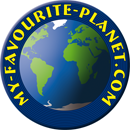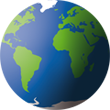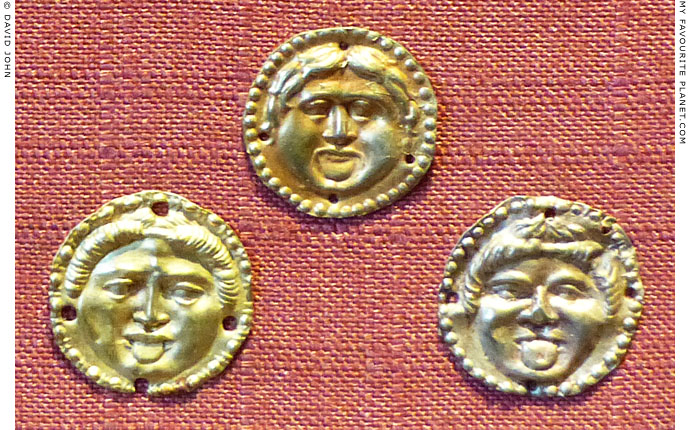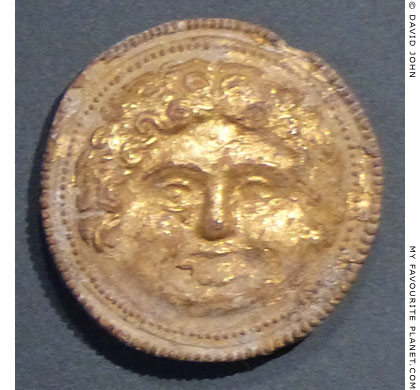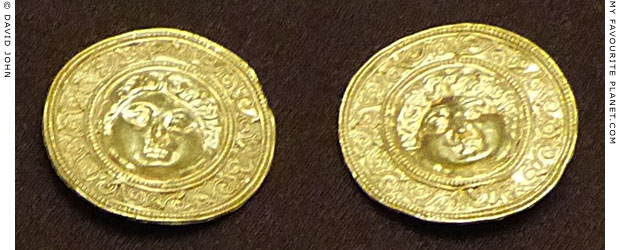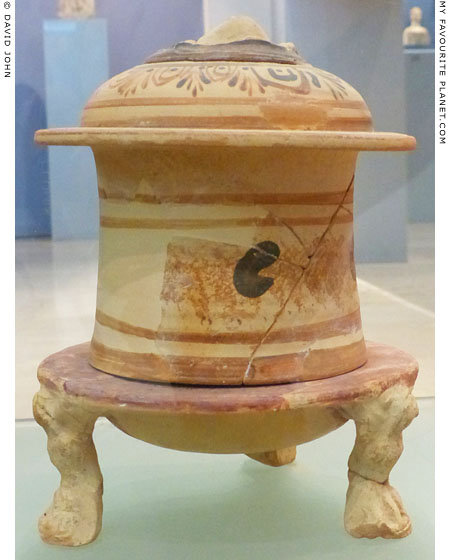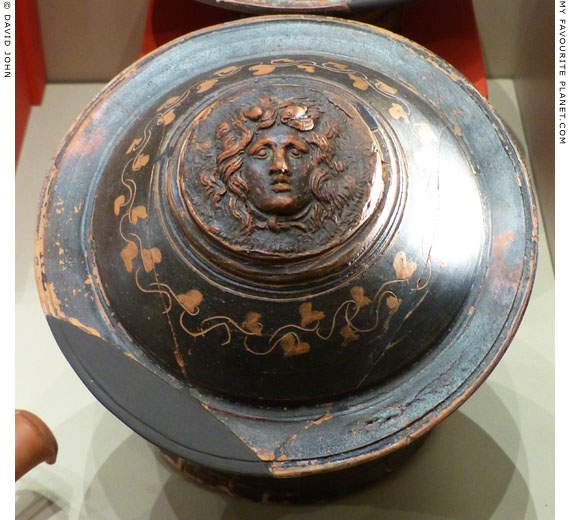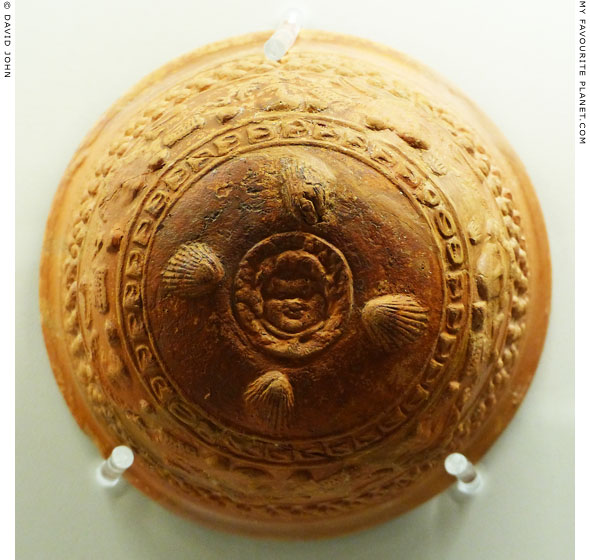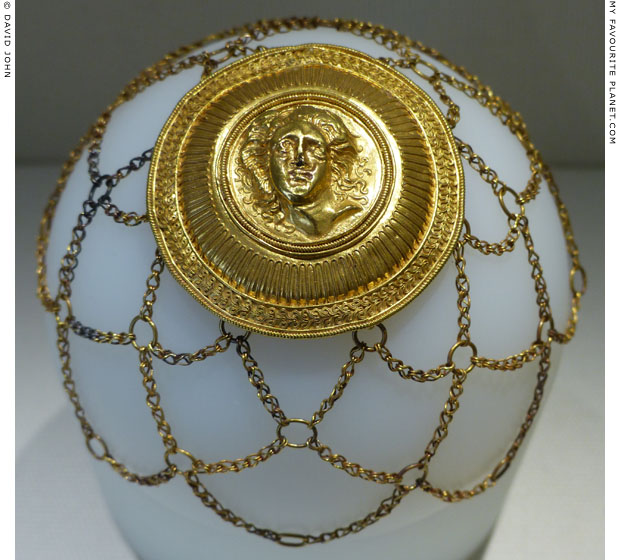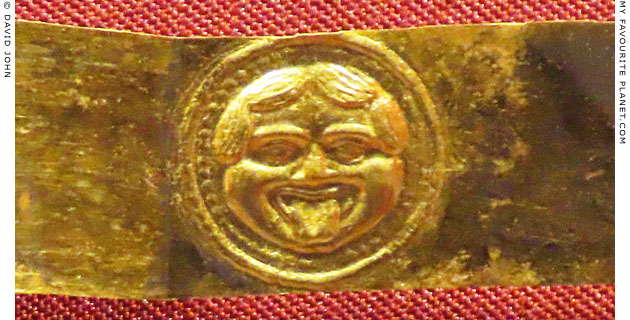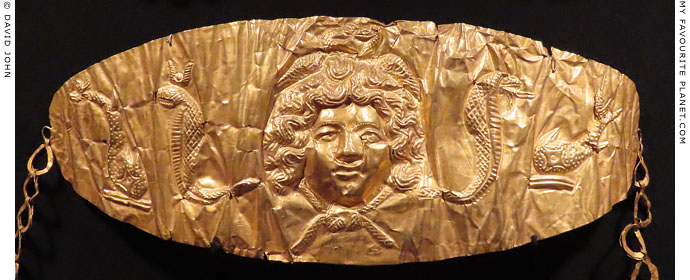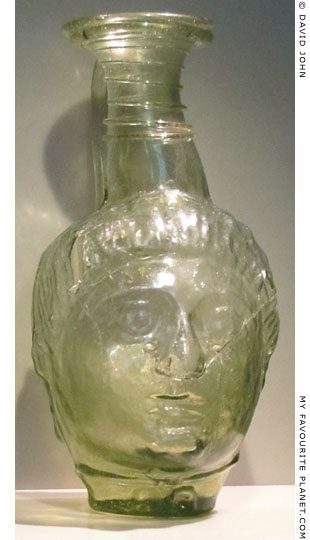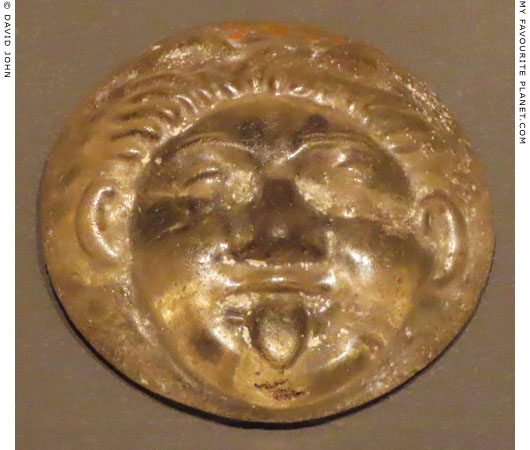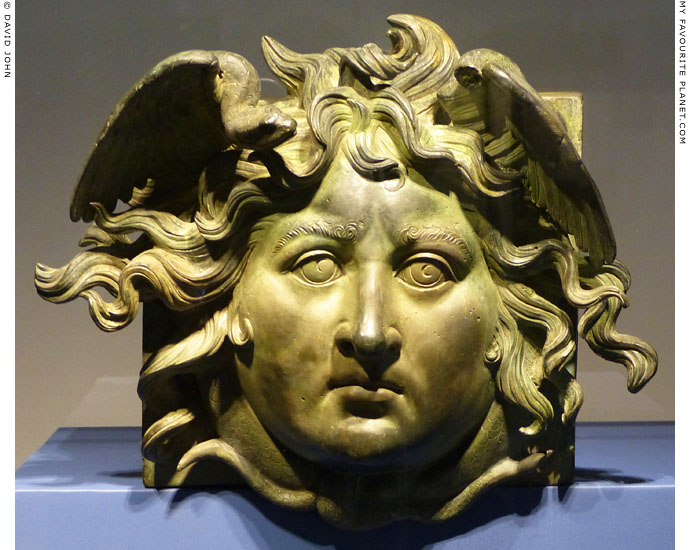|
|
|
| My Favourite Planet > English >
People > Medusa > part 7 |
 |
back |
Medusa – part 7 |
 |
Page 7 of 8 |
 |
|
| |
Gorgon decoration
on vessels and other objects |
| |
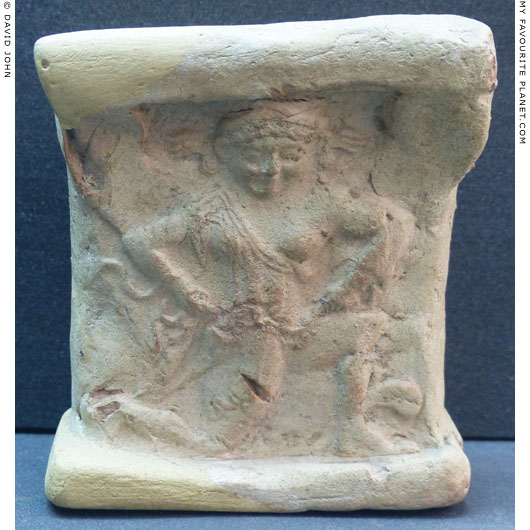
Relief of a running/flying Gorgon on a locally made ceramic tile.
From the area of the acropolis, Gela, Sicily. 6th century BC.
Gela Regional Archaeological Museum, Sicily. |
| |
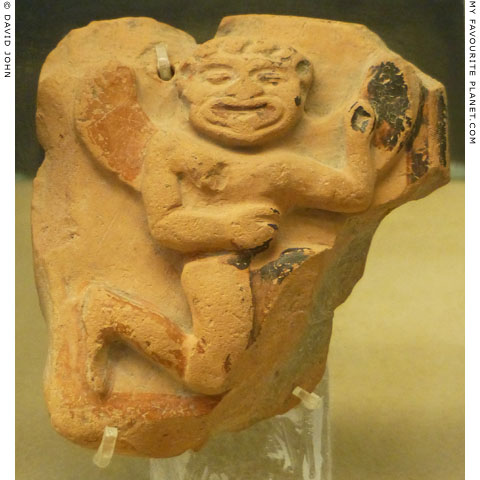
Relief of a running/flying Gorgon on a ceramic tile from the Northern Sanctuary
of Paestum, Italy. Made in an East Greek (Ionian) workshop, 6th century BC.
National Archaeological Museum of Paestum, Campania, Italy. |
| |
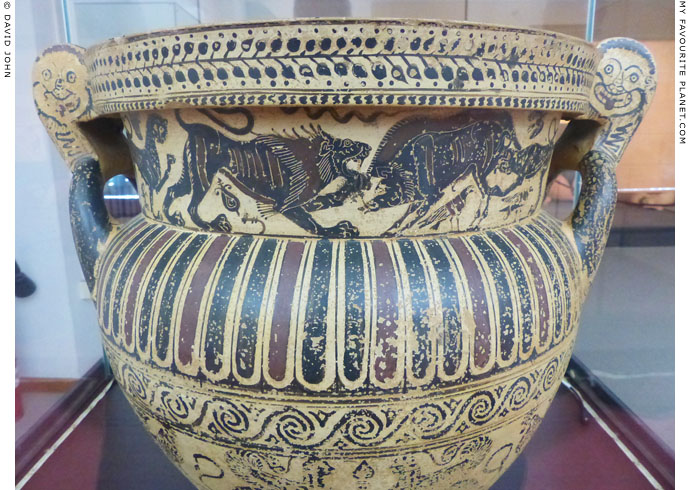
Painted Gorgoneions on the volutes of the handles of an Archaic Laconian
black-figure volute krater. 6th century BC. The painting on the neck depicts
a lion confronting a boar among birds and other animals.
Gela Regional Archaeological Museum, Sicily. |
| |
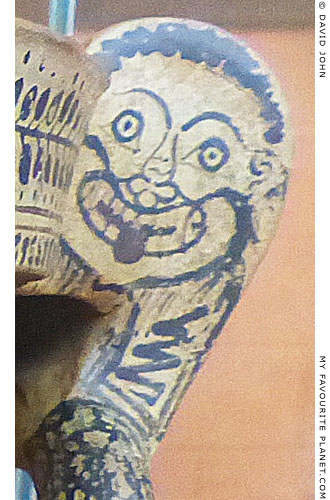
The Gorgoneion on the right-hand volute of the krater above. |
| |
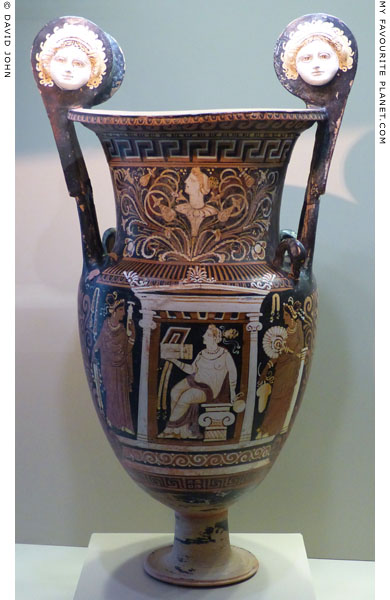
Painted Gorgoneion "mascaroons" on the volutes
of an Apulian red-figure volute krater.
2nd half of the 4th century BC.
Greek section, Civic Archaeological Museum, Milan. Inv. No. St. 135026.
|
The krater (vessel for mixing wine and water) is a funerary vase. The painting on the body depicts the deceased woman, identified by her pale skin, holding a coffer and sitting in her funerary monument which is in the form of a naiskos (ναΐσκος, diminutive of ναός, temple). She is visited by two female figures holding gifts, including an alabastron (perfume bottle), a fan and bands.
Each of the moulded Gorgon mascaroons has a white face, brown eyes and hair, and wears a white diadem (see photo below). Around the head are painted, snake-like locks. On the neck of the vessel a female head rises from a flower between symmetrically arranged tendrils. On each shoulder, between the bottom of the handles and the neck, is an attachment in the form of a black swan's head.
A similar krater displayed next to it in the museum depicts a deceased young man, shown in heroic nudity with his horse, also in a naiskos. The form and iconography of both kraters are typical of the "Ornate Style" (also referred to as the "Rich Style") of south Italian red-figure vase painting, thought to have been developed by the Iliupersis Painter around 375-350 BC. |
|
|
| |

The pretty Gorgon mascaroon on the left-hand volute of the krater above. |
| |
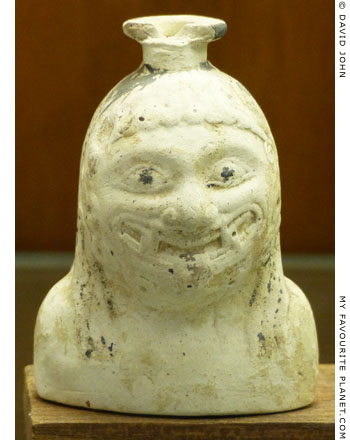
Archaic flask in the form of a Gorgon
bust with traces of colour.
East Greece. 590-570 BC.
Palazzo dei Conservatori, Capitoline Museums,
Rome. Inv. No. 306. |
| |
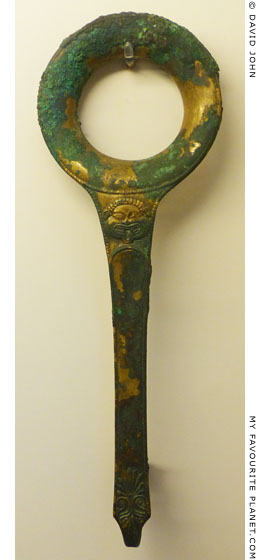 |
|
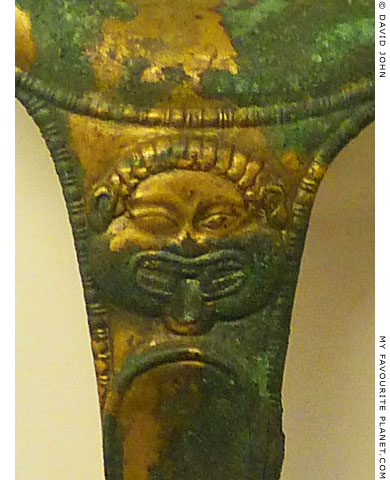 |
The Gorgon head on the handle of a bronze strainer.
From Syracuse. Made in Sicily, perhaps in Syracuse, about 500 BC.
The strainer's ring has a relief of the river god Acheloos, but it is
almost impossible to discern the figure on the corroded object.
British Museum. Inv. No. GR.1851.8-13.100 (Bronze 574).
From the Comarmond Collection. |
|
| |
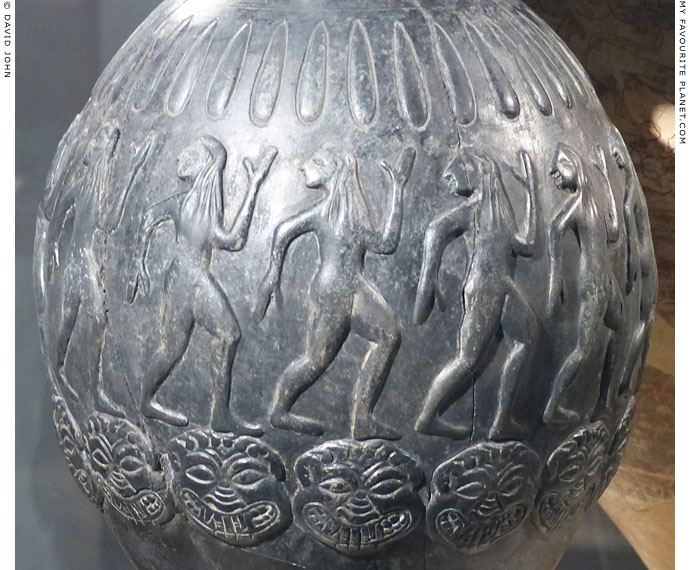
Detail of an Etruscan bucchero pesante oinochoe (wine jug) with an ovoid body,
decorated all around with rows of naked dancers and Gorgoneions in relief.
6th century BC. Height 50 cm, maximum diameter 23 cm, diameter of foot 18.8 cm.
Etruscan Section, Civic Archaeological Museum, Milan.
Inv. No. A 0.9.296. From the Seletti Collection.
|
The figures on the side of the oinochoe (οἰνοχόη) have been interpreted as dancers taking part in a sacred ritual dance, perhaps at a funeral, and the Gorgoneions probably had an apotropaic function.
Many of the objects in the Etruscan Section of the Milan Archaeological Museum are from excavations at the cemeteries of the Etruscan city Caere (today Cerveteri), northwest of Rome, while others, such as this oinochoe, are from private collections. The provenance of this jug is unknown, but it is thought to have been produced in Chiusi (Siena), southeastern Etruria. It was owned by the Milanese lawyer and historian Emilio Seletti (1830-1913), who donated most of his collection to Milan's civic museums at the end of the 1900s.
Bucchero (perhaps from the Spanish búcaro, or the Portuguese púcaro; derived from the Latin poculum, a drinking vessel) is the modern name given to Etruscan black ceramic ware with a glossy black surface, obtained by the reduction method of resticting oxygen in the kiln during firing. In the 6th century BC a variety of the bucchero type was developed, known as bucchero pesante or heavy bucchero. Such vessels had thicker walls, were often squatter and were decorated with reliefs, moulded separately and affixed to the still-damp clay before firing. The use of bucchero ware declined from the early 5th century BC due to the increasing popularity of imported Greek ceramics and then locally made vessels adapting new styles and techniques of pottery production and painting.
This oinochoe (Ancient Greek, οἰνοχόη; from οἶνος, oinos, wine, and χέω, kheo, I pour; plural oinochoai or oenochoai) is of the type known as trefoil, due to the form of its mouth which resembles a three-lobed ivy leaf. The inside of the mouth, at the top of the handle and at each side, is decorated with three relief heads (see photo below). |

The Etruscan oinochoe in the Milan museum. |
| |
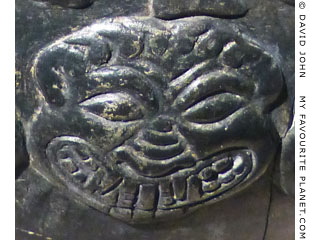
One of the Gorgoneions on the oinochoe. |
| |
| |
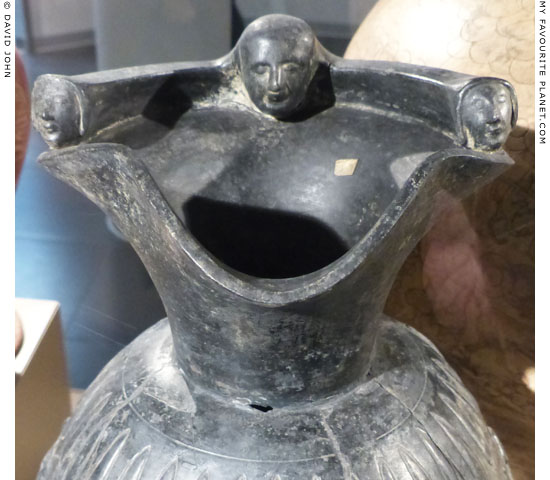
The protomes (heads, see note in Medusa part 4) on the
trefoil mouth of the Etruscan bucchero oinochoe in Milan. |
| |
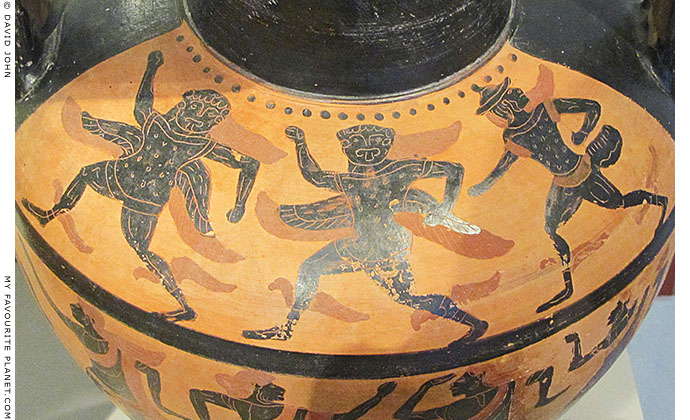
Detail of an Etruscan black-figure neck amphora ("Round Dance"), 525-500 BC,
by the Micali Painter, with dancing or running three-winged Gorgons, followed
by a winged male figure (Perseus?). All three figures also have winged ankles.
The vase is displayed in a glass cabinet against a wall, so it is not possible
to see the painting on the other side, or whether it shows from what or
whom who the figures appear to be fleeing.
Altes Museum, Berlin. Inv. No. V.I. 3226.
Acquired from the Collection Ancona in 1892. |
| |
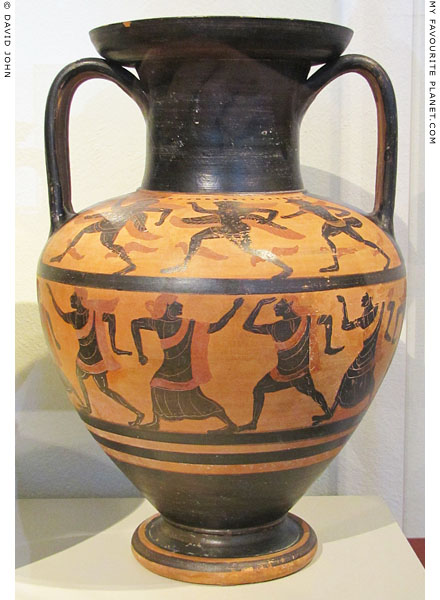
The front of the Etruscan "Round Dance" neck amphora in Berlin. |
| |
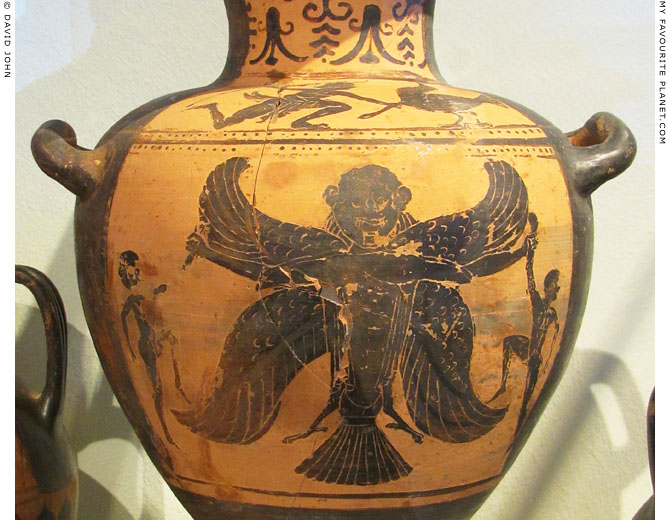
Detail of an Etruscan black-figure hydria, possibly by the Micali Painter,
showing a Harpy, the Demon of Death, with a head similar to that of a
Gorgon. The four-winged Harpy, with the body of a bird, holds a naked
human figure by the wrist in each hand of her outstretched arms.
530-500 BC. From Vulci, Etruria (Lazio, Italy).
Altes Museum, Berlin. Inv. No. F 2157. Acquired in 1834. |
| |
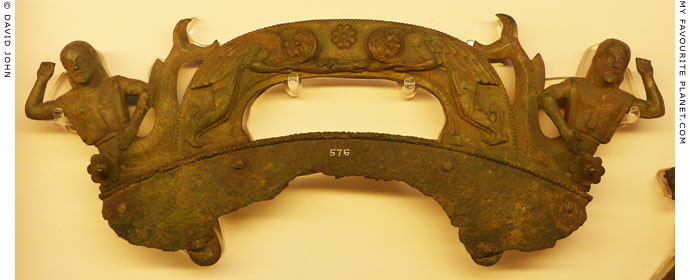
A bronze handle of a lid or dish, with Tritons and sleeping Gorgons (see detail below).
Made in southern Italy, perhaps at Croton, around 500 BC. One of a pair; the other, now in
Naples, has been described as "Ionic". National Archaeological Museum, Naples. Inv. No. 72981.
British Museum. GR 1824.4-89.31 (Bronze 576).
From Naples. Bequeathed by R. Payne Knight. |
| |
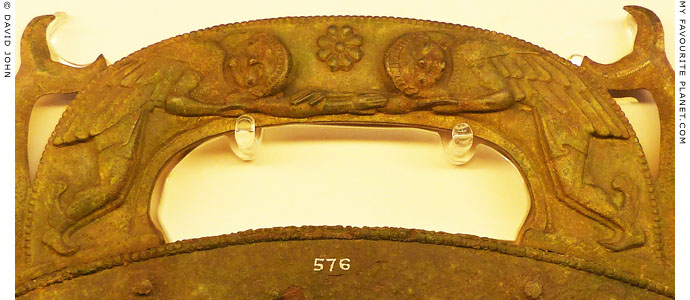
The sleeping Gorgons on the bronze handle above. The winged Gorgons also
have wings on their ankles, and stretch out their arms to touch each other.
|
In 1885 the Dutch art historian Jan Six (1857-1926) completed De Gorgone, his doctoral thesis on the Gorgon in ancient art and literature, and in September of the same year he wrote a paper examining Archaic Gorgons on artefacts in the British Museum.
He attempted to distinguish between types of Gorgons in Greek art, and discussed the theory that the Gorgon myth may have arrived in Greece from Asia via Cyprus, the southern Aegean and Dodecanese islands and Arcadia. "We may safely assume," he wrote, "that wherever the flood of material is most copious we are nearest to the source." He cited as evidence the "Golgoi sarcophagus" from Cyprus (see Medusa part 1), which turned out not to be as ancient as was perhaps at first thought, and the plate from Kamiros, Rhodes (see Medusa part 2). The "flood of material" never appeared, Archaic Gorgons from Cyprus and the Dodecanese have proved relatively rare (see for example, a fragmentary statue in Medusa part 2), and none appear to predate those found in other Greek territories.
Over a century later we appear no closer to being able to identify an "Ur-Gorgon", an original or prototype from which others were copied, or a geographical source for the myth.
Among the Archaic Gorgon depictions in the British Museum, Six was also drawn to the charming but baffling figures on this bronze handle.
"It would be hardly less interesting to know whence comes the handle of a large flat and circular or oval object from the Payne-Knight collection. If it is, as I suppose, Etruscan, we must of course despair of explaining its meaning. Yet it seems worth describing.
The real handle, on each side of which is a Triton, bears in relief two Gorgons bending forward in consequence of the shape of the handle, and sustaining each other by the elbow with outstretched hand. The knees are slightly bent, and the wings folded, which gives a very peculiar look to this strange composition. The heads are, of course, seen de face, but not upright. They belong to the same type as those already mentioned, but are much later. The figures are clad in a short folded garment, and wear shoes with large wings. The space between the heads is decorated by a rosette.
I dare not even guess what the meaning of all this may be, and should not like to follow those who find a family connection between Iris and Medusa, and might perhaps explain this as a symbolic picture of the rainbow resting on the waters. It will be best to accept it for the moment as merely decorative."
Jan Six, Archaic Gorgons in the British Museum. In: The Journal of Hellenic studies, Volume 6, pages 275-286. Society for the Promotion of Hellenic Studies, London, 1885. At the Internet Archive.
See also: Jan Six, Specimen literarium inaugurale de Gorgone (in Latin). De Roever Kröber-Bakels, Amsterdam, 1885. At the Internet Archive. |
|
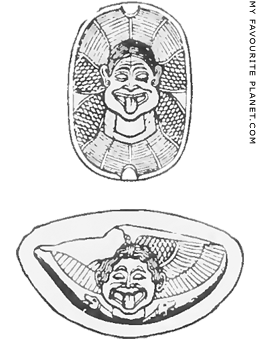
Woodcuts from drawings by
Jan Six of Gorgons on Etruscan
gems in the British Museum. |
|
| |
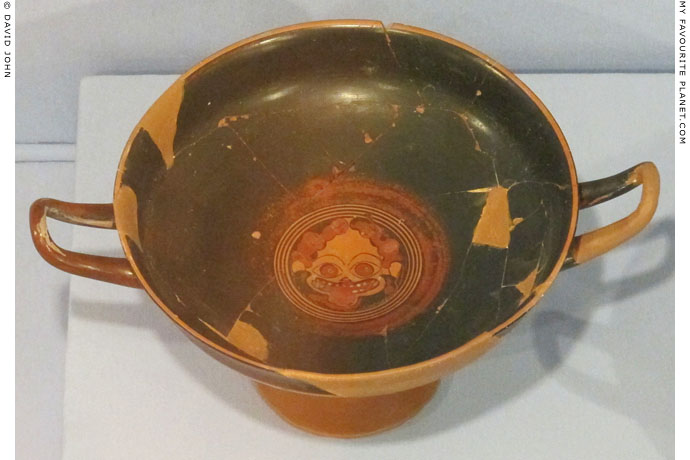
Gorgoneion on the tondo of a band cup from
Smyrna (today Izmir, Turkey). 6th century BC.
Izmir Archaeological Museum, Turkey. |
| |
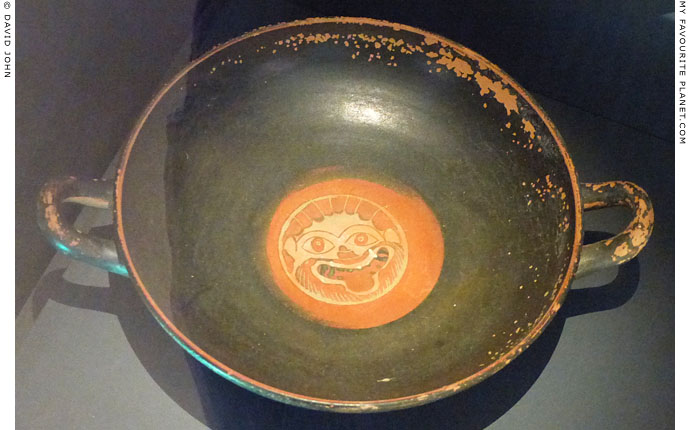
Gorgoneion on the tondo of a kylix (drinking cup)
found in Macedonia, northern Greece. 6th century BC.
Thessaloniki Archaeological Museum. |
| |

A Gorgoneion in the tondo of an Attic black-figure kylix, late 6th century BC.
From a inhumation burial of an adult in a terracotta larnax, Macri Langoni T 116 (55).
Circa 500 BC. Found during excavations in the cemetery at Macri Langoni, near the
ancient city of Kamiros, western Rhodes, Dodecanese.
Rhodes Archaeological Museum. |
| |
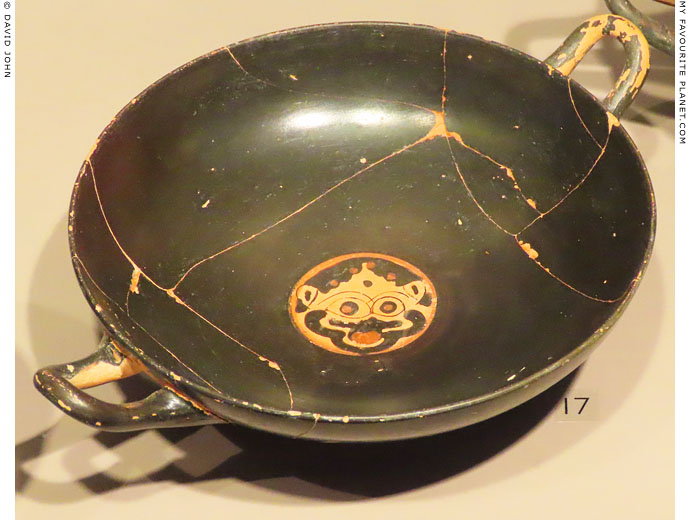
Gorgoneion in the tondo of an Attic black-figure kylix,
one of three similar kylikes on display in Kos museum.
Late 6th century BC. From Kos, Dodecanese.
Kos Archaeological Museum. |
| |
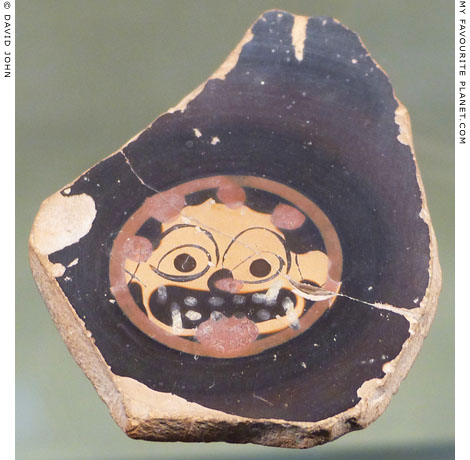
Gorgoneion as the tondo of a fragment of a kylix (drinking cup).
5th century BC. Found in the area of an Ionic temple
in the Via Consiglio Regionale, Syracuse, Sicily.
Paolo Orsi Regional Archaeological Museum, Syracuse. Inv. No. 45673. |
| |
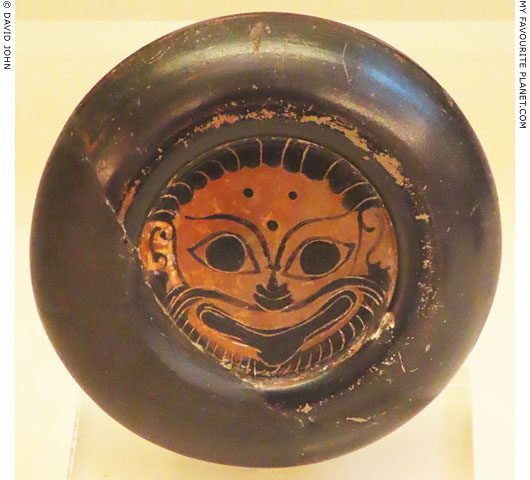
Gorgoneion in the tondo of an Attic black-figure diskarion, a small
flat dish with a curved rim used as a stand for a large vessel.
Around 500-450 BC. Found among offerings in tombs at
Agios Andreas and Scorpio Potami, Marathon, Attica.
Marathon Archaeological Museum. |
| |

Gorgoneion in the tondo of an Attic black-figure kylix. This Gorgon
looks rather masculine with its enormous jaw and chin.
Around 500-470 BC. Provenance unknown, but probably from Halkidiki, Macedonia, Greece.
Polygyros Archaeological Museum. From the Lambropoulos Collection. |
| |
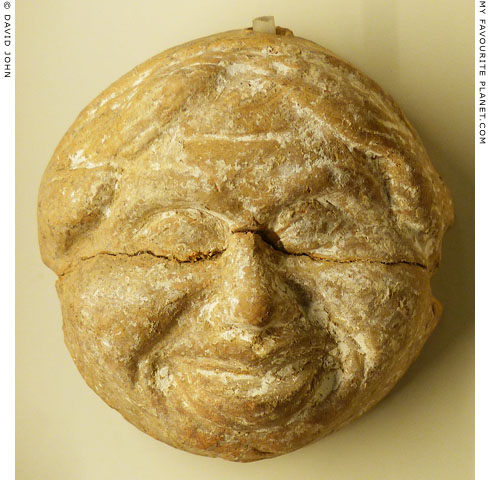
A small terracotta Gorgoneion, as a votive offering at
the rural sanctuary of the Chthonic deities to the west
of Orchomenos (Ὀρχομενός), Boeotia, central Greece.
4th century BC.
The underworld deities worshipped at the sanctuary included
Demeter and Persephone and the Graces (Χάριτες, Charites),
whose cult, according to Pindar and Pausanias, was one of
the most ancient at the lakeside city Orchomenos.
Thebes Archaeological Museum. |
| |
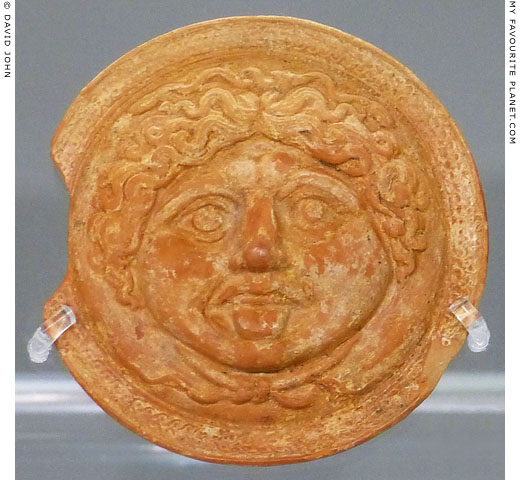
A terracotta Gorgoneion as a seal for a workshop
producing vases with relief decoration.
4th century BC. From Piraeus, Attica, Greece.
Piraeus Archaeological Museum. |
| |
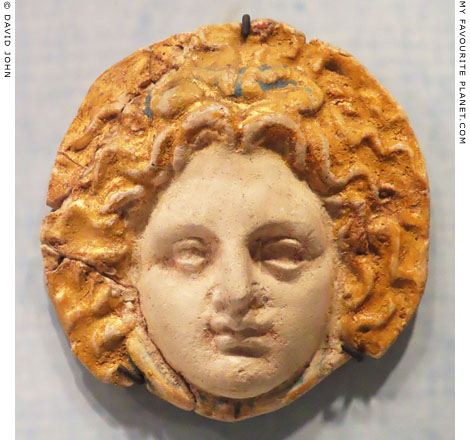
A painted ceramic plaque in the form of a Gorgoneion of the
"beautiful type". The impassive face, without a potruding
tongue, is white, the hair golden with traces of deep blue.
4th century BC. From Greece.
Allard Pierson Museum, Amsterdam. Inv. No. 1049. |
| |
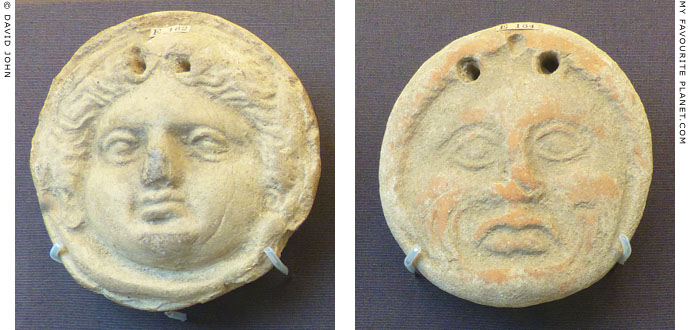
Gorgoneions on two round ("discoid") terracotta loom weights (shown at the same
scale). Such weights for weaving looms were often dedicated at sanctuaries.
Made on Sicily around 400-100 BC. From ancient Akragas or Gela.
British Museum.
Left: Inv. No. GR 1863,0728.202 (Terracotta E 162). Diameter 7.62 cm (3 inches).
Right: Inv. No. GR 1863,0728.195 (Terracotta E 164). Diameter 7.3 cm (2 7/8 inches).
Donated by George Dennis in 1863.
See another of the loom weights from Sicily donated by George Dennis,
and a note about their provenance in Homer part 3. |
| |

The lid of a large Apulian terracotta relief pyxis with a Gorgoneion.
Around 300 BC. From Canosa, Apulia, southeast Italy.
Height 11.6 cm, circumference 21.6 cm.
Museum für Kunst und Gewerbe Hamburg. Inv. No. 1917.680 a-b (pyxis and lid).
From the Johannes W. F. Reimers Collection.
|
A pyxis (πυξίς; plural, Πυξίδες, pyxides; from πῠ́ξος, pyxos, boxwood), was a type of box with a separate lid, generally cylindrical and originally made of wood, but later made of metal or clay. Pyxides were used mainly by woman to hold cosmetics, toiletries, jewellery and other small objects.
This example was found in "Tomba Reimers" (or Ipogeo Reimers), a chamber tomb at Canosa (Ancient Greek, Κανύσιον; Latin, Canosium; Italian, Canosa di Puglia), Apulia, southeast Italy, named after the businessman, painter and collector Johannes W. F. Reimers, who was present when the grave was discovered and purchased all the ceramic objects found there. After Reimers' death in 1913, the Hamburg museum, after some difficulty, managed to acquire his large collection of antiquities in 1917, including over 1500 Greek and Italic ceramic objects.
Reimers appears to have travelled widely, built his collection with relatively modest means, and later displayed objects in his own museum. Considering the size and importance of his collection, surprisingly little has been written about him or the objects. |
|
|
| |
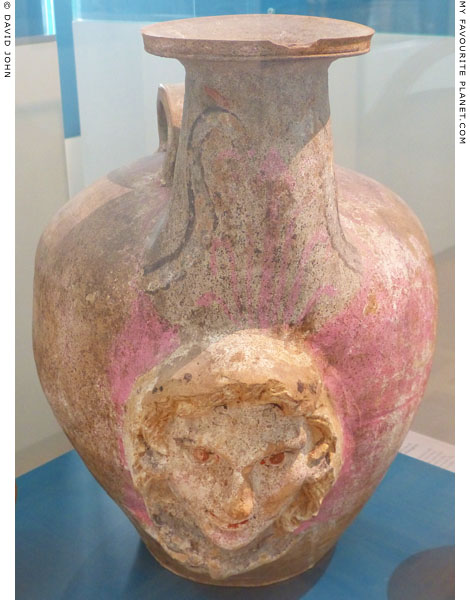
A Canosa askos, a large polychrome ceramic vase, with
a painted relief of a Gorgoneion applied to the body.
Around 350-300 BC. From Canosa, Apulia, southeast Italy.
Height 45 cm, width 35 cm, width of mouth 14.3 cm, width of foot 17.5 cm.
Museum für Kunst und Gewerbe Hamburg. Inv. No. 1917.971.
From the Johannes W. F. Reimers Collection (see above).
|
It is thought that other masks were also originally applied around the body of the vessel. An askos (ἀσκός, tube; plural, ἀσκοί, askoi) was originally a wineskin, but askoi were later made of metal or clay, often used for storing oil.
Askoi of several types were made in Apulia around 350-300 BC, probably exclusively for use in graves. They were painted with water-soluble pigments (perhaps a mixture similar to tempera) in blue, pink/red, purple, yellow and brown, on a white background. Reliefs and three-dimensional figures (including Gorgoneions, Nikes, winged heads) were fired separately and fixed to the body with an adhesive made of a resin-like pitch. Some feature elaborate statuette-like figures on the top of the body or handles. The non-durable colouring and fragile attachments indicate that the vessels were not intended for practical use, and had a purely sacred decorative function.
Although this askos is displayed in the same case as objects from the "Tomba Reimers" at Canosa (see above), the museum labelling does not state its age or provenance. The Gorgoneion is similar to those on a sphageion (σφαγείων, vessel for collecting blood during ritual sacrifices) with two Gorgoneions from Canosa, dated late 4th - early 3rd century BC, now in the Pushkin Museum, Moscow. |
|
|
| |
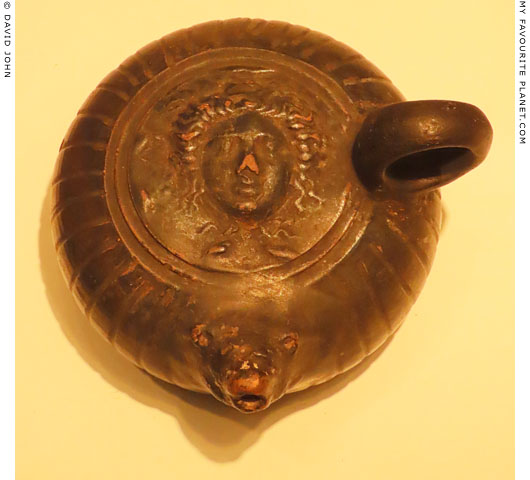
An ceramic oil lamp with a relief of a Gorgoneion on top
and a spout in the form of a lion/panther head.
Hellenistic period (?).
"Hellenistic Cabinet". Allard Pierson Museum, Amsterdam. |
| |
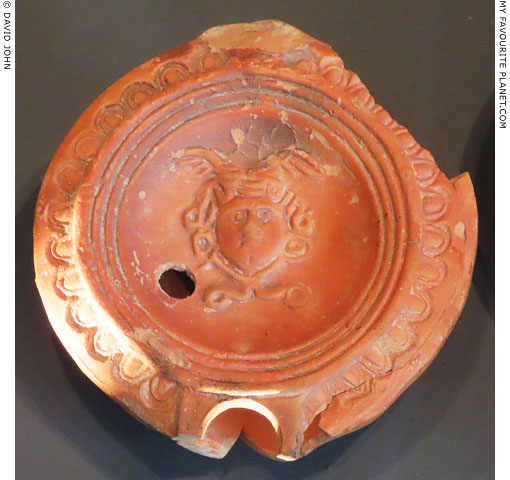
A terracotta oil lamp with a relief of a winged Gorgoneion on top.
Reign of Empror Vespasian, 69-79 AD. Found in the Hellenistic balaneion
(baths) in the Ancient Agora, Thessaloniki, first built in the 2nd century BC.
Thessaloniki Archaeological Museum. |
| |
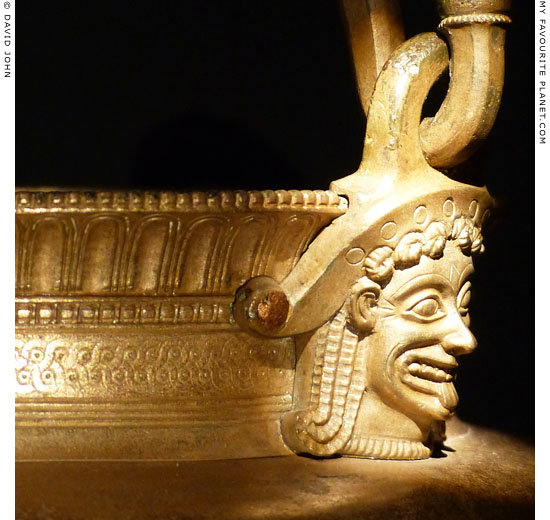
A handle attachment of a bronze situla (used for mixing wine and water at
banquets) in the form of an Archaistic Gorgoneion, attached to the vessel by
rivets. This type of vessel, similar to a krater in form and function, is also referred
to as a kados (ancient Greek, κάδος). The rings above the attachments were used
to suspend the vessel by ropes or chains.
From a cist grave in Dangli Street, Stavroupolis, Thessaloniki. Late 5th - early 4th
century BC. Height of vessel with handle 36.5 cm; without handle 23.5 cm.
Thessaloniki Archaeological Museum. Inv. No. MΘ 5124. |
 |
|
|
| |
| |
 |
| |
 |
| |
 |
| |
 |
| |
 |
| |
 |
| |
George Alvanos
rooms in
Kavala's historic Panagia District
Anthemiou 35,
Kavala, Greece
kavalarooms.gr
|
| |
Olive Garden Restaurant
Kastellorizo,
Greece
+30 22460 49 109
kastellorizo.de
|
| |
Papoutsis
Travel Agency
Kastellorizo,
Greece
+30 22460 49 286
greeklodgings.gr
|
| |
|
